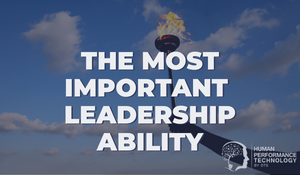In a Nutshell: Transformational Leadership
Transformational leadership is one of the most popular, well-researched and well-respected theories of leadership that exists today. Research conducted by Lowe and Gardner involving content analysis of The Leadership Quarterly issues published from 1990 to 2000 found that over one third (34%) of all research was on the subject. There is a great deal of interest in the concept perhaps foremost because it is measurable and a substantial amount of evidence showing that it is positively related to employee satisfaction, motivation and performance.
Transformational leadership, often used interchangeably with the term "charismatic leadership," was initially brought to the public's attention by the Pulitzer Prize winning writer and political biographer James MacGregor Burns in his classic work “Leadership” (1978). In the book, Burns described two main types of leadership: “transactional,” focused on offering carrot-and-stick incentives in exchange for performance, and “transforming,” focused on growing together through the relationship between the leader and follower. Burns drew on Maslow's hierarchy of needs to explain that transforming leadership elevates people from lower to higher level needs; increasing their sense of self-worth and developing their potential, not just exerting control over followers.
In 1985, Bernard M. Bass, most well known for his classic text “The Bass Handbook of Leadership,” expanded on the work of Burns to develop what is today referred to as Bass’ Transformational Leadership Theory, and as such most authors employ the term "transformational" instead of "transforming." Bass differed from Burns by giving more attention to needs of the followers and outlined transformational leadership on a continuum together with transactional leadership and Laissez-Faire leadership. Bass also developed the Multifactor Leadership Quiz (MLQ) to assess one’s leadership style, and the quiz is used as one of the primary methods to quantify leadership.
The transformational leadership style shares close parallels with the servant leadership philosophy.
Overview:
Transformational leadership is a type of leadership style that enhances the motivation of followers through mainly non-coercive mechanisms. These mechanisms typically include things like being an inspirational role model, having a compelling vision that gives followers a sense of identity and purpose, and acting to enhance followers' sense of self-worth, as well their growth and potential so that they are transformed into becoming leaders themselves.
 (Fig. 8.1, Leadership Continuum, Leadership Theory and Practice, Peter G. Northhouse, p190)
(Fig. 8.1, Leadership Continuum, Leadership Theory and Practice, Peter G. Northhouse, p190)
Transformational leadership is typically contrasted against “transactional leadership,” where leaders approach followers with an eye to exchanging one thing for another (e.g., a bonus for higher performance). While the defining feature of transactional leadership is a two-way exchange ("I'll give you this if you give me that"), the main features of transformational leadership are inspiration, trust, growth, intrinsic motivation, and a sense of mission or purpose.
The extent to which a leader is transformational can be measured in terms of his or her influence on the followers and the extent to which these followers feel trust, admiration, loyalty and the motivation to work harder than would normally be expected.
Oprah Winfrey typifies the qualities of a modern-day transformational leader — someone who has dedicated the greater part of her life towards helping others grow and develop, spreading a message of hope and compassion around the world, and sharing hundreds of examples of positive changes made in people's lives which have in turn inspired millions of others to strive to be better human beings themselves.
People typically want to do things for a transformational leader because they are inspired by what they do and say, and therefore want to be part of their cause. These leaders are often energetic, optimistic, passionate and persuasive — some quality or characteristic attracts others to them — which is why the term charismatic leadership is sometimes used as a synonym.
A range of different definitions can be used to help explain the concept more fully:
- “Transformational leadership occurs when one or more persons engage with others in such a way that leaders and followers raise one another to higher levels of motivation and morality.” — Burns
- "Transformational leadership is concerned with improving the performance of followers and developing followers to their fullest potential." — Bass & Avolio
- "Transformational leaders focus on followers, motivating them to high levels of performance, and in the process, help followers develop their own leadership potential." — Riggio
- “Transformational leadership is in some ways an expansion of transactional leadership… specifying the conditions and rewards these others will receive if they fulfill those requirements. Transformational leadership, however, raises leadership to the next level. [It] involves inspiring followers to commit to a shared vision and goals for an organisation or unit, challenging them to be innovative problem solvers, and developing followers’ leadership capacity via coaching, mentoring, and provision of both challenge and support." — Bass and Riggio
- “Transformational leadership is fundamentally morally uplifting." — Avolio
You might be wondering: "How do I apply transformational leadership? What does it look like in practice?" To answer this question, we have provided two of the most popular models of transformational leadership: the first from Bass, the second from Kouzes and Posner.
1) Bass’ 4 Components of Transformational Leadership (The 4 I’s): In his book “Transformational Leadership” (1998), Bass introduced four main components of transformational leadership that are now frequently referred to and used in the measurement of the construct:
- Idealised Influence/Charisma (Trust): Transformational leaders act in ways that make them role models. They are respected, admired and trusted. Followers identify with them and describe them in terms that imply extraordinary capabilities, persistence and determination. These leaders are willing to take risk. They can consistently be relied upon to do the right thing, displaying high moral and ethical standards.
- Inspirational Motivation (Inspiration): These leaders embody the term "team spirit." They show enthusiasm and optimism, providing both meaning and challenge to the work at hand. They create an atmosphere of commitment to goals and a shared vision.
- Intellectual Stimulation (Creativity): A transformational leader encourages creativity and fosters an atmosphere in which followers feel compelled to think about old problems in a new way. Public criticism is avoided.
- Individualised Consideration (Growth): Transformational leaders act as mentors and coaches. Individual desires and needs are respected. Differences are accepted and two-way communication is common. These leaders are considered to be good listeners, and along with this comes personalised interaction. Followers of these leaders move continually toward development of higher levels of potential.
2) Kouzes and Posner's 5 Practices of Transformational Leadership: One of the most widely taught models of transformational leadership was developed by Kouzes and Posner, popularised in their bestselling book "The Leadership Challenge," first published in 1987, and which some have described as the “best leadership field guide ever written.” From interviews of over 1,000 executives, Kouzes and Posner determined that there were 5 core practices of excellent leadership (each core factor having a further 2 sub-factors):
- Model the Way: Clarify ValuesSet the Example
- Inspire a Shared Vision: Envision the FutureEnlist Others
- Challenge the Process: Search For OpportunitiesExperiment and Take Risks
- Enable Others to Act: Foster CollaborationStrengthen Others
- Encourage the Heart: Recognise ContributionsCelebrate the Values and Victories
Since there isn't necessarily a definitive way of practicing transformational leadership, many consultants, researchers and authors will have their own take on the subject. What is important to keep in mind is that the transformational approach is broad-based, includes many elements, and has numerous interpretations since being first introduced in the 70s. The essence of transformational leadership might well be captured in the popular quote by John Quincy Adams: "If your actions inspire others to dream more, learn more, do more and become more, you are a leader."
Sources:
- Leadership Theory and Practice (2013), Peter G. Northhouse, p185-217T
- he Bass Handbook of Leadership (2008), 4th Edition, Bernard M. Bass, p618-648
- Transformational Leadership (1998), Bernard M. Bass, Ronald E. Riggio
- Improving Organisational Effectiveness through Transformational Leadership (1993), Bernard M. Bass , Bruce J. Avolio
- Leadership (1978), James MacGregor Burns
- The Leadership Challenge (2008), James M. Kouzes and Barry Z. Posner
- A Contemporary Consideration of Transformative Leadership, Journal of Curriculum and Instruction (JoCI), James O. McDowelle, 2009
- Identification of Transformational Leadership Qualities: An Examination of Potential Biases, European Journal of Work and Organisational Psychology, Filip Lievens, Pascal Van Geit, and Pol Coetsier, 1997
- Are You a Transformational Leader?, Psychology Today, Ronald E. Riggio, Ph.D., 2009
- Transactional leadership and transformational leadership (Apsc.gov.au)
- Transformational Leadership (Mindtools.com)
- Transformational and Transactional Leadership (Businessballs.com)
This article offers an expanded description of the summary listed in our post 40 Must-Know HR, OD, L&D Models.

Theo Winter
Client Services Manager, Writer & Researcher. Theo is one of the youngest professionals in the world to earn an accreditation in TTI Success Insight's suite of psychometric assessments. For more than a decade, he worked with hundreds of HR, L&D and OD professionals and consultants to improve engagement, performance and emotional intelligence of leaders and their teams. He authored the book "40 Must-Know Business Models for People Leaders."



We Would Like to Hear From You (0 Comments)